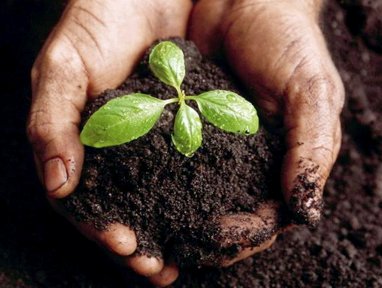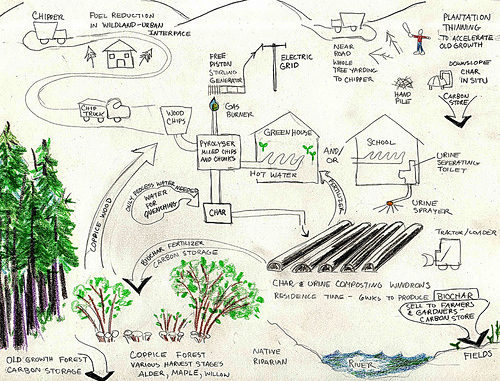Biochar: Difference between revisions
mNo edit summary |
mNo edit summary |
||
| Line 22: | Line 22: | ||
*inexpensive soil amelioration for degraded land | *inexpensive soil amelioration for degraded land | ||
* | *need less land = lower startup costs for a Global Village | ||
*increased biomass productivity | *increased biomass productivity | ||
*efficient use of biomass waste for energy generation | *efficient use of biomass waste for energy generation | ||
*reduced need for | *reduced need for fertilizer input (e.g. manure), which is important for the planned [http://openfarmtech.org/index.php?title=Permaculture_Plantout_at_Factor_e_Farm Permaculture Plantout at Factor e Farm]. | ||
*Combine biochar with vermicompost to make superb fertilizer. | |||
*Pyrolysis gas can be used for energy (i.e. [http://openfarmtech.org/index.php?title=Compressed_Fuel_Gas compressed fuel gas]) and as a heat source (e.g. for heating greenhouses). As a source of hydrogen, CO and small amounts of methane, pyrolysis gas may be useful for various processes | *Pyrolysis gas can be used for energy (i.e. [http://openfarmtech.org/index.php?title=Compressed_Fuel_Gas compressed fuel gas]) and as a heat source (e.g. for heating greenhouses). As a source of hydrogen, CO and small amounts of methane, pyrolysis gas may be useful for various processes | ||
*[http://openfarmtech.org/index.php?title=Pyrolysis_Oil_from_Biomass Bio-oil] and tars are also by-products of pyrolysis, can be turned into biodiesel | *[http://openfarmtech.org/index.php?title=Pyrolysis_Oil_from_Biomass Bio-oil] and tars are also by-products of pyrolysis, can be turned into biodiesel | ||
| Line 31: | Line 32: | ||
*Biochar for sale as a source of income for an emerging community. | *Biochar for sale as a source of income for an emerging community. | ||
*Charcoal already needed for other purposes, e.g. metal smelting | *Charcoal already needed for other purposes, e.g. metal smelting | ||
*Charcoal can be used for water purification and filtration, later become biochar | *Charcoal as filter: can be used for water purification and filtration, later become biochar; can be used to filter pyrolysis gas itself | ||
* | *Lastly, charcoal can also help neutralize smell in a composting toilet. Then it becomes biochar, ultimately. | ||
Revision as of 18:18, 18 January 2009
Background
According to the International Biochar Initiative:
Biochar is a fine-grained charcoal high in organic carbon and largely resistant to decomposition. It is produced from pyrolysis of plant and waste feedstocks. As a soil amendment, biochar creates a recalcitrant soil carbon pool that is carbon-negative, serving as a net withdrawal of atmospheric carbon dioxide stored in highly recalcitrant soil carbon stocks. The enhanced nutrient retention capacity of biochar-amended soil not only reduces the total fertilizer requirements but also the climate and environmental impact of croplands. Char-amended soils have shown 50 - 80 percent reductions in nitrous oxide emissions and reduced runoff of phosphorus into surface waters and leaching of nitrogen into groundwater. As a soil amendment, biochar significantly increases the efficiency of and reduces the need for traditional chemical fertilizers, while greatly enhancing crop yields. Renewable oils and gases co-produced in the pyrolysis process can be used as fuel or fuel feedstocks. Biochar thus offers promise for its soil productivity and climate benefits.
Some of the world's most productive soils (e.g. Canadian prairies, Russian Chernozem / or "black earth") are very rich in organic carbon. This is now thought to be pyrogenic in origin, likely originating from prairie or forest fires. The black carbon is often thousands of years old, demonstrating its stability in soil. For more extensive background on Biochar, please refer to the Wikipedia entry
The Biochar Economy
(image from Flickr user visionshare by CC license)
Biochar in the OSE context
So how does Biochar fit into the OSE scope and product ecology ?
- inexpensive soil amelioration for degraded land
- need less land = lower startup costs for a Global Village
- increased biomass productivity
- efficient use of biomass waste for energy generation
- reduced need for fertilizer input (e.g. manure), which is important for the planned Permaculture Plantout at Factor e Farm.
- Combine biochar with vermicompost to make superb fertilizer.
- Pyrolysis gas can be used for energy (i.e. compressed fuel gas) and as a heat source (e.g. for heating greenhouses). As a source of hydrogen, CO and small amounts of methane, pyrolysis gas may be useful for various processes
- Bio-oil and tars are also by-products of pyrolysis, can be turned into biodiesel
- Use Lifetrac to mix char into soil, till
- Biochar for sale as a source of income for an emerging community.
- Charcoal already needed for other purposes, e.g. metal smelting
- Charcoal as filter: can be used for water purification and filtration, later become biochar; can be used to filter pyrolysis gas itself
- Lastly, charcoal can also help neutralize smell in a composting toilet. Then it becomes biochar, ultimately.
Specifics
For information on small-scale gardening, please refer to the Gardening with Biochar FAQ, an excellent resource.
Links
Wikipedia entry on Biochar [1]
Gardening with Biochar FAQ [2]
BioEnergy Lists: Terra Preta (Biochar) [3]
International Biochar Initiative (IBI) [4]
Biochar Fund [5]

